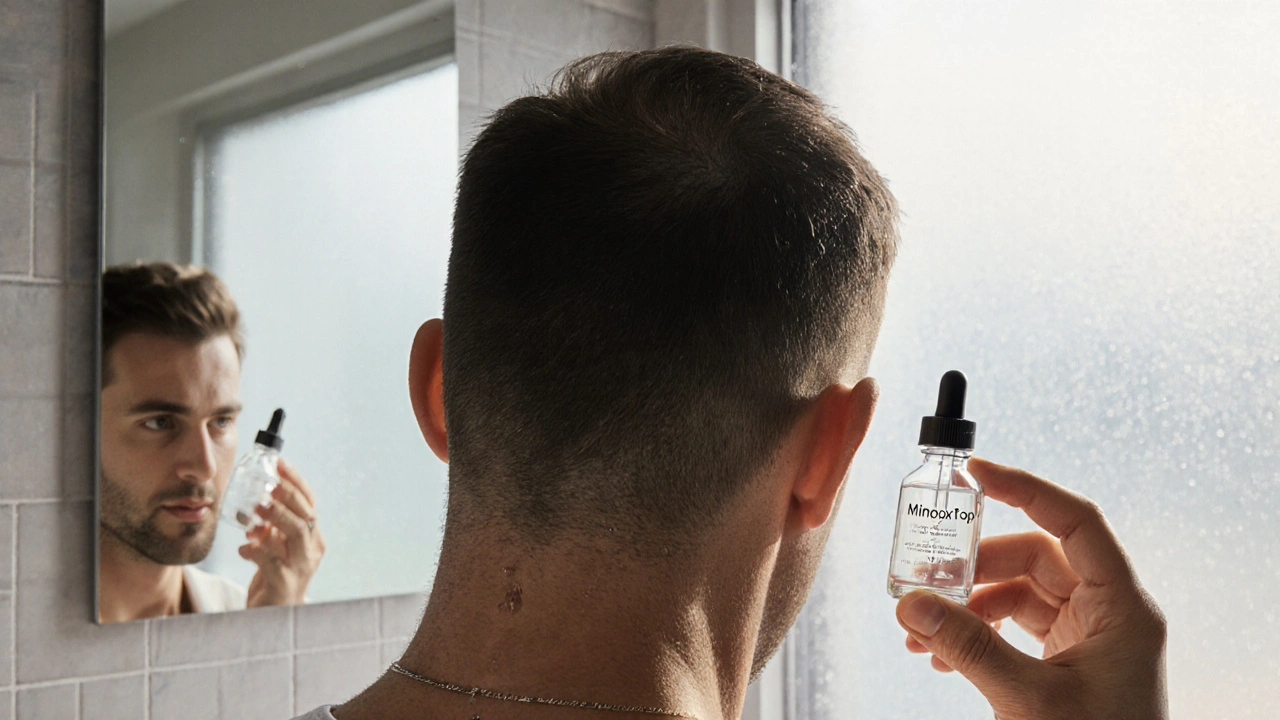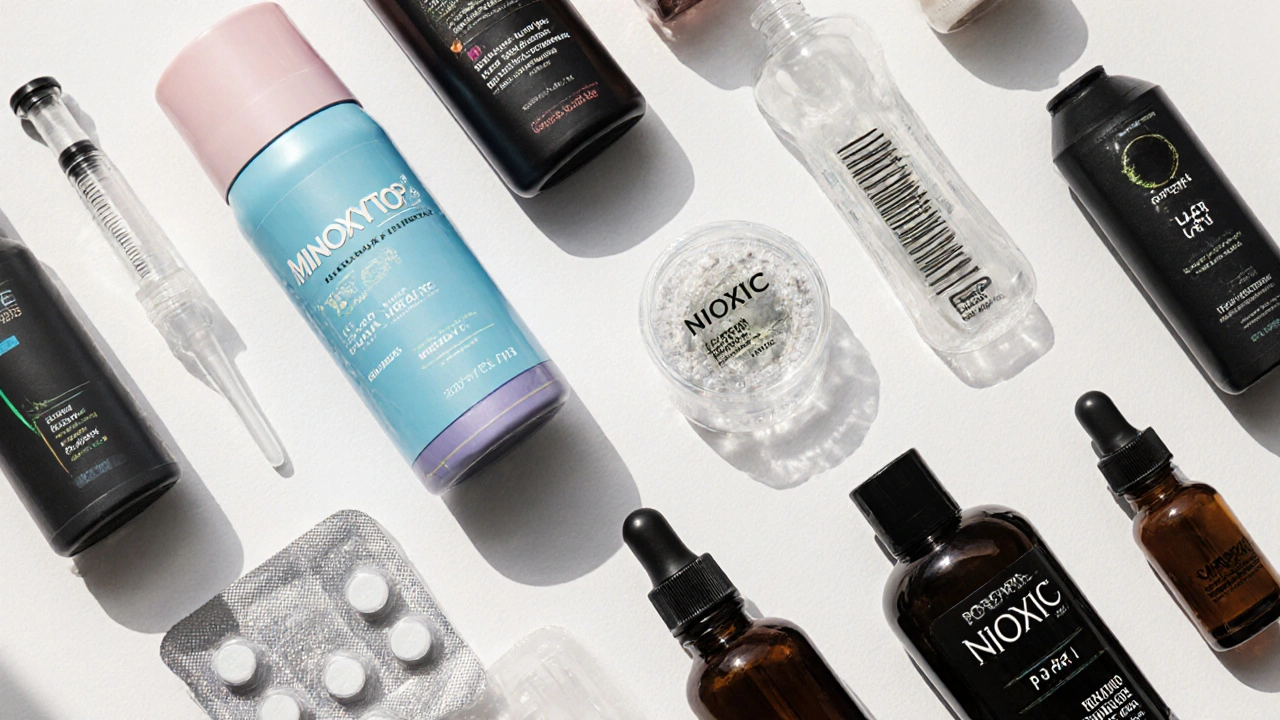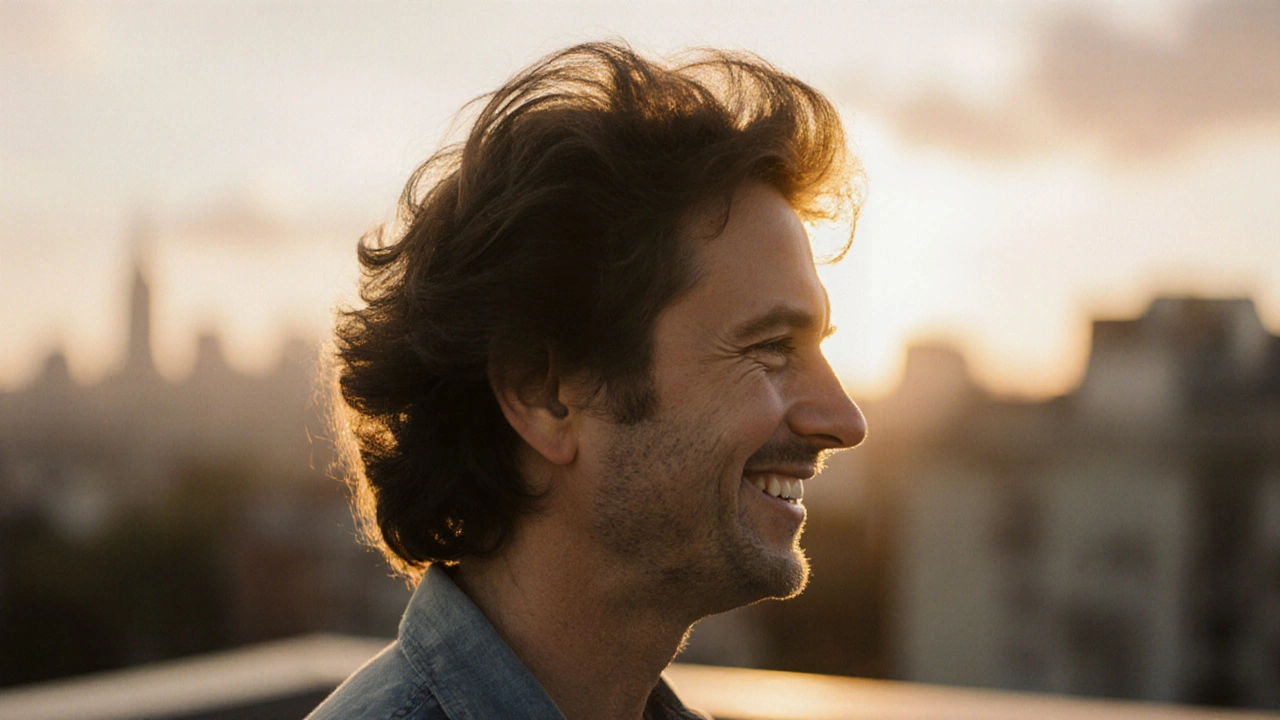Minoxytop vs Other Hair Loss Treatments: Full Comparison Guide
 Oct, 8 2025
Oct, 8 2025
Hair Loss Treatment Comparison Tool
Compare Hair Loss Treatments
Select two treatments to compare their features side-by-side.
Comparison Results
Select two treatments above and click Compare to see detailed information.
If you’ve tried to fight thinning hair, you’ve probably seen dozens of product names, each promising a fuller mane. The real question isn’t “which one sounds the best?” but “which one actually works for you?” This guide breaks down Minoxytop - a popular minoxidil brand - and lines it up against the most common alternatives. By the end you’ll know the key differences, costs, side‑effects and which option fits your scalp type, budget and lifestyle.
What is Minoxytop?
Minoxytop is a topical solution that contains the active ingredient minoxidil. It comes in a 5% concentration for men and 2% for women, applied twice daily to the affected areas of the scalp. Minoxytop is FDA‑approved for androgenetic alopecia and is sold over‑the‑counter in Australia at an average price of AU$45 for a 60‑ml bottle.
Clinical studies show that consistent use for at least four months can produce a 10‑15% increase in hair density. The mechanism is simple: minoxidil widens blood vessels, boosting nutrient flow to hair follicles and extending the growth phase (anagen) of the hair cycle.
Typical side‑effects are mild - scalp irritation, itching or temporary shedding during the first few weeks. Most users tolerate it well, but it’s not a miracle cure; results plateau after a year of use, and discontinuation leads to rapid loss of any new growth.
Top Alternatives to Minoxytop
While Minoxytop is a solid choice for many, other strategies may work better depending on your situation. Below are the most widely used alternatives, each with its own strengths and drawbacks.
Rogaine (brand name for minoxidil) offers a foam formulation at the same 5% concentration for men and 2% for women. The foam is easier to apply without dripping and often feels less greasy. Price ranges from AU$50 to AU$60 for a 60‑ml container.
Finasteride is an oral prescription drug that blocks the conversion of testosterone to dihydrotestosterone (DHT), the hormone responsible for follicle miniaturisation. The standard dose is 1mg daily, costing around AU$30 per month. It’s proven to halt hair loss in up to 90% of men, but can cause sexual side‑effects in a small percentage.
Laser Therapy devices use low‑level laser light (LLLT) to stimulate cellular activity in hair follicles. Handheld combs and caps range from AU$200 for a basic unit to over AU$1,500 for clinic‑grade caps. Sessions are brief (10‑15minutes) and painless, but scientific support is moderate.
Platelet‑Rich Plasma (PRP) injections involve drawing the patient’s blood, concentrating platelets, and injecting the plasma into the scalp. Clinics charge AU$400‑AU$800 per session, typically requiring three sessions spaced a month apart. PRP can improve thickness in both men and women, but the price is a barrier for many.
Nioxin is a three‑step system of shampoo, conditioner and scalp treatment that combines vitamins, antioxidants and botanical extracts. It’s marketed for thinning hair rather than baldness. A full set costs about AU$70 and works best when used consistently.
Ketoconazole Shampoo (e.g., Nizoral) contains an antifungal that also reduces scalp inflammation and DHT locally. It’s used 2‑3 times per week at a cost of AU$20‑AU$30 for a 200‑ml bottle. Some users see modest regrowth when combined with other treatments.
Rosemary Oil is a natural essential oil that, when diluted with a carrier oil, has been shown in a 2015 clinical trial to be as effective as minoxidil after six months of twice‑daily application. A small bottle costs around AU$15, but consistency is key.

Side‑by‑Side Comparison
| Product | Active Ingredient | Formulation | Typical Concentration | Price (AU$) | Application Frequency | Pros | Cons |
|---|---|---|---|---|---|---|---|
| Minoxytop | Minoxidil | Liquid solution | 5% (men) / 2% (women) | 45‑55 | Twice daily | OTC, clinically proven, easy to buy | Scalp irritation, requires lifelong use |
| Rogaine Foam | Minoxidil | Foam | 5% / 2% | 50‑60 | Twice daily | Less greasy, quick absorption | Higher price, same lifelong commitment |
| Finasteride | Finasteride | Oral tablet | 1mg | 30/month | Once daily | Stops DHT, works on crown and vertex | Potential sexual side‑effects, prescription only |
| Laser Therapy | Low‑level laser light | Handheld/Cap device | N/A | 200‑1,500 (one‑time) | 10‑15min, 3‑4times/week | Non‑invasive, painless | Mixed research, expensive up‑front |
| PRP Injections | Platelet‑rich plasma | Injectable | N/A | 400‑800/session | 3sessions, then maintenance | Uses own blood, can boost thickness | High cost, requires clinic visits |
| Nioxin System | Vitamins & botanicals | Shampoo/Conditioner/Treatment | N/A | ~70 (full set) | Daily | Improves scalp health, easy routine | Limited regrowth, mainly cosmetic |
| Ketoconazole Shampoo | Ketoconazole | Shampoo | 2% | 20‑30 | 2‑3times/week | Reduces scalp inflammation, cheap | Only modest results alone |
| Rosemary Oil | Rosemary essential oil | Oil blend | N/A (diluted) | ~15 | Twice daily | Natural, low side‑effects | Requires consistent use, less research |
How to Pick the Right Treatment for You
- Identify the pattern of loss. If you’re losing hair mainly at the crown, a DHT‑blocking drug like Finasteride often outperforms topical minoxidil. Vertex‑only thinning may respond well to Minoxytop.
- Consider gender and hormone factors. Women generally benefit from lower‑strength minoxidil (2%) or hormone‑balancing options such as topical spironolactone, not listed here.
- Set a budget. OTC liquids/foams run about AU$45‑60 per bottle, while clinic procedures (PRP, laser) can exceed AU$1,000.
- Check for sensitivities. If you have a sensitive scalp, the foam version or a natural oil like Rosemary may cause less irritation than a liquid solution.
- Evaluate convenience. Oral Finasteride is a once‑daily pill, while Minoxytop needs twice‑daily application and a few minutes of drying time.
- Think long term. All effective treatments require ongoing use. Stopping Minoxytop or Finasteride will typically revert to the pre‑treatment state within months.

Tips for Getting the Best Results
- Apply Minoxytop (or any topical) to a clean, dry scalp. Wait at least 30minutes before styling or using hair products.
- Rotate application sites if you notice irritation. A small amount of aloe‑gel can soothe redness.
- Combine treatments wisely. For example, using Minoxytop alongside a ketoconazole shampoo can boost efficacy without extra cost.
- Track progress with photos every four weeks. Hair growth is gradual; visual evidence helps you stay motivated.
- Maintain a healthy diet rich in iron, zinc, and omega‑3 fatty acids. Nutrients support follicle health and may enhance any medication’s effect.
- Consult a dermatologist before starting oral Finasteride or PRP, especially if you have underlying medical conditions.
Frequently Asked Questions
Can I use Minoxytop and Finasteride together?
Yes. The two work on different pathways - Minoxytop expands blood flow while Finasteride blocks DHT. Many dermatologists prescribe both for maximum effect, but you should monitor for side‑effects and discuss dosage with your doctor.
Is the foam version of minoxidil better than the liquid?
Foam dries faster and feels less greasy, which many users prefer. Efficacy is essentially the same if the concentration matches. Choose based on personal comfort.
How long before I see results with Minoxytop?
Most people notice reduced shedding after 2‑3months and visible regrowth after 4‑6months. Patience is key; stopping early will erase gains.
Are natural oils like rosemary actually effective?
A 2015 double‑blind study showed rosemary oil performed comparably to 2% minoxidil over six months. Results vary, but it’s a low‑risk, inexpensive option for mild thinning.
What should I do if I experience scalp irritation from Minoxytop?
Try applying a smaller amount, reduce frequency to once daily, or switch to the foam version. If irritation persists, discontinue use and consult a dermatologist.
Can I use laser caps and Minoxytop together?
Yes, they are complementary. Laser stimulates follicles while minoxidil improves blood flow. Use the laser first, then apply Minoxytop once the scalp is dry.
Is there a age limit for starting Minoxytop?
Minoxytop is approved for adults 18years and older. Younger users should only use it under a physician’s guidance, as hair loss patterns differ in teens.
Whether you stick with Minoxytop, switch to another product, or combine treatments, the key is consistency and realistic expectations. With the right plan, you can keep thinning hair at bay and maybe even win back a little extra volume.

Bill Bolmeier
October 8, 2025 AT 19:40Wow, this guide really breaks the fog around hair loss options-feels like a lighthouse for anyone drowning in product hype! I love how it lays out the pros and cons side by side so you can actually compare apples to apples without the usual marketing fluff. If you’re on a budget, the OTC liquids like Minoxytop give you a solid starting point, and you can always layer a cheap ketoconazole shampoo for extra scalp health. Remember, consistency beats miracle; stick with your chosen routine for at least four months before judging the results. Keep the momentum, and you’ll see that stubborn thinning start to ease up.
Darius Reed
October 14, 2025 AT 04:54Thats a great post!!
Karen Richardson
October 19, 2025 AT 14:07First, let us establish that the terminology used throughout the article is generally accurate, which is commendable. Second, the statistical data regarding the efficacy of minoxidil are consistent with peer‑reviewed literature. Third, the side‑effect profile is presented without exaggeration, noting only mild irritation in most cases. Fourth, the comparison table correctly distinguishes between topical and systemic treatments. Fifth, the price ranges reflect the current Australian market, not outdated figures. Sixth, the recommendation to combine ketoconazole shampoo with minoxidil aligns with evidence of synergistic anti‑androgenic action. Seventh, the advice to monitor progress with photographs is a standard practice in dermatology. Eighth, the article rightly cautions against premature discontinuation, which would reverse any gains. Ninth, the discussion of laser therapy appropriately mentions the mixed research outcomes. Tenth, the note on PRP’s high cost is factual and helps set realistic expectations. Eleventh, the emphasis on diet and nutrient intake is supported by several nutrition studies. Twelfth, the suggestion to consult a dermatologist before starting finasteride is prudent and responsible. Thirteenth, the mention that minoxidil is approved for adults 18 and older is legally accurate. Fourteenth, the statement that rosemary oil performed comparably to 2% minoxidil in a 2015 trial is correctly cited. Finally, the overall tone is balanced, providing both optimism and realism without veering into hyperbole.
AnGeL Zamorano Orozco
October 24, 2025 AT 23:21Honestly, reading this feels like stepping onto a grand stage where every treatment struts its stuff under a blinding spotlight, each promising to rescue those desperate follicles from the abyss of baldness. The drama of Minoxytop versus Rogaine foam, the tragic romance of finasteride’s hormonal battle, the futuristic sci‑fi vibe of laser caps, and even the humble, earthy whisper of rosemary oil-all play out in a symphony of hope and disappointment that could melt even the toughest skeptic. Yet, beneath the glitter of price tags and sleek packaging lies a simple truth: no miracle, just relentless dedication, and perhaps a dash of patience that most of us lack in a world of instant gratification. So, while the table dazzles, remember that success hinges on daily rituals, personal tolerance, and the stubbornness to stick with it long after the novelty fades.
Cynthia Petersen
October 30, 2025 AT 08:35Ah, the classic “which miracle cure will finally give me a full head of hair?” as if any of these potions were conjured by a wizard. Spoiler: they’re all just chemically tweaked scalp treatments that need you to be a glorified hamster on a daily dosing schedule. Still, kudos for actually laying out the price differences-nothing like watching your wallet shrink faster than your hairline.
Marcia Hayes
November 4, 2025 AT 17:49Great summary-helpful and straightforward.
Danielle de Oliveira Rosa
November 10, 2025 AT 03:03When we contemplate the journey of hair restoration, it is valuable to remember that each solution is a reflection of our deeper desire for control over the natural aging process. Minoxytop, with its accessible liquid form, invites a disciplined ritual, while finasteride asks us to confront hormonal mechanisms at a systemic level. The interplay between external application and internal modulation reminds us that the body is an integrated whole, not a collection of isolated parts. Thus, choosing a path should involve both empirical evidence and a mindful assessment of one’s own lifestyle, emotional resilience, and long‑term commitment.
Tarun Rajput
November 15, 2025 AT 12:17Dear reader, it is with a measured cadence that I commend the author for assembling a comprehensive tableau of therapeutic avenues, each meticulously cataloged alongside fiscal considerations and pharmacologic nuance. While the exposition excels in breadth, one might further enrich the discourse by integrating longitudinal meta‑analytic data that benchmark sustained efficacy across diverse demographic cohorts. Moreover, a brief exposition on the mechanistic underpinnings of low‑level laser therapy would satiate the intellectually curious. Nonetheless, the guide succeeds in demystifying a market often cloaked in hyperbole, thereby empowering the discerning consumer.
Joe Evans
November 20, 2025 AT 21:30👍 Super helpful guide! 👍 I love how it breaks down each option without the usual jargon. 👍 If you’re on a budget, stick with Minoxytop and maybe add a cheap ketoconazole shampoo. 👍 Consistency is 🔑, so set a reminder and don’t skip days! 👍
Colin Boyd
November 26, 2025 AT 06:44Well, the guide is thorough but you could argue that the laser devices are overpriced for the limited evidence available
John Petter
December 1, 2025 AT 15:58Interesting overview.
Annie Tian
December 7, 2025 AT 01:12The guide is comprehensive; however, it would be beneficial to include a brief note on the importance of consulting a dermatologist before initiating any systemic therapy; additionally, a reminder to monitor for side‑effects regularly; overall, a solid starting point for anyone exploring treatment options.